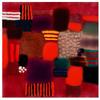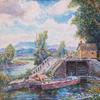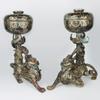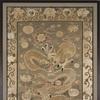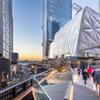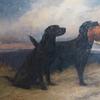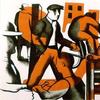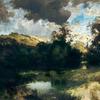David Winton Bell Gallery at Brown University Presents "Danny Lyon: The Only Thing I Saw Worth Leaving"
- PROVIDENCE, Rhode Island
- /
- October 18, 2018
The David Winton Bell Gallery at Brown University is presenting a special exhibition of more than 100 photographs by Danny Lyon (b. 1942) drawn from the Gallery’s collection and four films on loan from the artist. Danny Lyon: The Only Thing I Saw Worth Leaving complements the Brown Arts Initiative’s “On Protest, Art & Activism” programming on the occasion of the 50th anniversary of 1968, a tumultuous year for the country. A rigorous survey of Lyon’s photojournalistic practice in the 1960s, the exhibition is organized around five topics that Lyon has referred to frequently when discussing his work: empathy, freedom, history, destruction and narrative.
On view from November 2 through December 19, 2018, Danny Lyon: The Only Thing I Saw Worth Leaving is curated by Allison Pappas, a Graduate Curatorial Assistant at Brown. On November 1, at 5:30 pm, there will be a conversation with Lyon followed by a reception in the List Art Building Auditorium adjacent to Bell Gallery, free and open to the public. Seating for this program is limited. Register at https://lyon.eventbrite.com.
The exhibition features photographs from four of Lyon’s most significant series: Memories of the Southern Civil Rights Movement (1962–1964), The Bikeriders (1963–1966), The Destruction of Lower Manhattan (1966–1967) and Conversations with the Dead (1967–1968), about the Texas prison system. The films include Llanito (1972), profiles of people living in rural communities in New Mexico; El Mojado (1974), following the plight of undocumented workers from Mexico; Dear Mark (1981), a tribute to the artist Mark di Suvero; and Born to Film (1982), featuring generations of Lyon’s family and friends.
While the subjects are disparate, the images are connected by Lyon’s solidarity and humanity, and his desire to draw attention to inequity and discrimination, especially among the marginalized. Interaction and personal participation in the lives of his subjects are a vital component of Lyon's practice, enabling him to communicate their personalities and circumstances authentically and nonjudgmentally.
Bell Gallery Director Jo-Ann Conklin said, “We are delighted to present this important work from our collection that captures the volatility of the 1960s through Danny Lyon’s lens. His photographs eloquently amplify Brown Arts Initiative’s programming examining protest, art and activism on the anniversary of 1968. It was a pivotal year on campus, when 65 African American students walked out of classes to protest Brown’s limited enrollment of black students. This act of resistance led to the creation of the University’s Rites and Reason Theatre and Department of Africana Studies.”
Empathy: Memories of the Southern Civil Rights Movement
In 1962, Lyon traveled to Cairo, Illinois, the summer before his senior year at the University of Chicago to photograph demonstrators protesting segregation, many of whom were also students. John Lewis, then a field secretary for the Student Non-Violent Coordinating Committee (SNCC), encouraged Lyon to get more involved with the Civil Rights Movement. The following year he returned, becoming SNCC’s first staff photographer.
Over the next two years, Lyon followed the protests across the South, and his photographs distributed by SNCC helped form a public image of the movement. He published a set in his book, Memories of the Southern Civil Rights Movement (2010).
Freedom: The Bikeriders
The photographs published in his celebrated photobook, The Bikeriders (1968), were made between 1963 and 1966 to both record and glorify a classic American lifestyle. It was a way of life that Lyon experienced personally as a member of the Chicago Outlaws bikers club, photographing and bonding with those with whom he rode. Lyon’s photographs of the bikers reflect the quest for freedom that is an essential part of American identity. As such, they serve as a stark contrast to the photographs portraying the experiences of prisoners enduring years of incarceration and activists fighting for equality.
History: The Destruction of Lower Manhattan
Lyon moved back to his native New York City in 1966, settling into a community of artists in lower Manhattan. Sixty acres of buildings in this part of the city were effectively leveled and rebuilt, making way for the World Trade Center and the new urban landscape of Wall Street prosperity. Lyon documented the demolition for two years in a project funded by the New York State Council on the Arts, ultimately publishing the photobook The Destruction of Lower Manhattan (1969). Buildings, blocks and entire neighborhoods disappeared, and with them some of the city’s oldest built environments.
Destruction: Conversations with the Dead
Lyon was given open access by the Texas Department of Corrections to photograph in six prison units in 1967—working prison farms, a penitentiary, and a treatment center. He worked for two years with free access, developing lifelong friendships along the way. Lyon’s intention was to “somehow emotionally convey the spirit of imprisonment.” To this end, Lyon published Conversations with the Dead: Photographs of Prison Life with the Letters and Drawings of Billy McCune (1969), incorporating the writings and drawings of a prisoner he befriended. A year later, Lyon organized an exhibition of his photographs and McCune’s drawings at Rice University with the support of Dominique de Menil, a Houston patron of the arts. McCune later appeared in Born to Film.
Narrative: Films and Other Work
Stories are essential to Lyon’s work. He accompanies his photographs with written content in his photobooks, a combination of his own and those of the subjects. Whether in films, books, collages constructed out of photographs and snapshots from throughout his life, or individual photographs, Lyon has presented countless narratives. This section of the exhibition features three films alongside a casual portrait of John Lennon, Civil Rights activists like James Baldwin and James Forman, doomed buildings in Manhattan, biker friends, a collection of photographs from a new prisoner’s wallet, and, poignantly, an open road in rural Mississippi.
Pappas said, “Lyon’s oeuvre evokes many stories—collective and individual—explicitly detailing a particular reality in time and place and revealing chapters of American history, elements of identity and a diversity of human experiences. The narrative power of Lyon’s films and photographs helps to encourage empathy, define freedom, recount history and admonish destruction. As he said in 1967, ‘I am left feeling the people I photograph are the best people in America. I leave to the future the only thing I saw worth leaving.’”
The photographs are gelatin silver prints, unless otherwise noted, and are from the collection of the David Winton Bell Gallery, Brown University. The films are on loan from the artist.
About Danny Lyon
Born in Brooklyn, New York, in 1942, Danny Lyon received a B.A. in 1963 from the University of Chicago. Since 1967, he has been an independent photographer and an associate at Magnum Photos. During the 1970s, he contributed to the Environmental Protection Agency’s DOCUMERICA project. Lyon works in the style of photographic New Journalism where the photographer becomes embedded with the subjects he documents. He is the founding member of the publishing group Bleak Beauty.
Lyon has had monographic exhibitions at the Art Institute of Chicago; Center for Creative Photography at the University of Arizona; Crystal Bridges Museum of American Art; de Young Memorial Museum; Menil Collection; Museum of Modern Art (MoMA); and Whitney Museum of American Art. His work is in the permanent collections of the American Museum of Art, Smithsonian Institution; Art Institute of Chicago; the J. Paul Getty Museum; Metropolitan Museum of Art; MoMA; Whitney Museum of American Art; and many other institutions. Lyon is the recipient of two Guggenheim Fellowships (1969, 1978); a National Endowment of the Arts award (1983); a Rockefeller Foundation Fellowship (1990); Honorary Doctorate of Fine Arts from The Art Institute of Boston (1995); Missouri Honor Medal for Distinguished Service in Journalism (2011) and a Lucie Award (2015) from the Lucie Foundation.
About David Winton Bell Gallery
The David Winton Bell Gallery, an affiliated program of the Brown Arts Initiative, is Brown University's contemporary art gallery and home to an important part of the University's permanent art collection. The Gallery hosts four to five exhibitions each year, annual exhibitions of student artwork and a triennial exhibition of artwork by Brown faculty members.
Broadly concerned with the presentation of exemplary work by artists living today, the Bell Gallery takes pride in showing artwork irrespective of media, content or subject and makes special efforts to support and show the work of emerging or under-recognized practitioners. Alongside the contemporary arts, the Gallery also makes use of its art historical collections, programming exhibitions on the arts and culture of the last five centuries. The Bell Gallery maintains a permanent collection of more than 6,000 works of art, dating from the 16th century to the present, with particularly rich holdings in contemporary art and works on paper.
Founded in 1971, the Gallery is named in memory of David Winton Bell, a member of the Brown University class of 1954. It is housed in the Albert and Vera List Art Building designed by internationally renowned architect Philip Johnson, that also includes classrooms, lecture halls, and extensive studio space. Free and open to the public, the Gallery is open Monday – Wednesday and Friday 11 am – 4 pm; Thursday 1 – 9 pm; and Saturday and Sunday 1 – 4 pm, and located at 64 College Street in Providence, Rhode Island.

